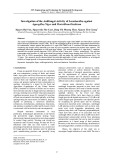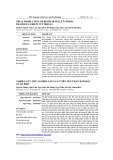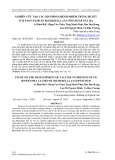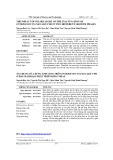
KHOA HỌC SỨC KHỎE
Volume 3, Issue 4 89
ANTIBACTERIAL ACTIVITY OF BIOPIGMENTS EXTRACTED
FROM LABORATORY GROWN CULTURE OF SPIRULINA
PLATENSIS
Phan Thi Thanh Nga1 Pham Minh Diep2
Tran Mai Anh3 Pham Thi Bich Dao4
1, 2, 3, 4Thanh Do University
Email: thanhngato09@gmail.com1; mdiep12a4@gmail.com2; manhtrann298@gmail.com3;
ptbdao@thanhdouni.edu.vn4
Received: 7/10/2024; Reviewed: 28/10/2024; Revised: 4/11/2024; Accepted: 16/12/2024
DOI: https://doi.org/10.58902/tcnckhpt.v3i4.178
Abstract: Spirulina platensis biopigments have been potential source of nutritional,
pharmacological and cosmetical purposes due to the presence of bioactive pigments. In this study,
Spirulina platensis was culture in the labotory to extract using a glucose/glycerol and water-based
NADES. The chlorophyll a,b and carotenoid pigment concentration were 110.04
9.58 and 89.25
21.46
g/mL, respectively. While the highest phycocyanin content was obtained as 2.25
0.2 mg/mL.
The biopigment components extracted from Spirulina platensis in natural deep eutectic solvent (Sp-
NADES) were tested in vitro for their antibacterial activity for which one Gram positive bacterium
(Staphylococcus aureus) and four Gram negative bacteria (Escherichia coli, Pseudomonas aeruginoas,
Salmonella typhi, and Klebsiella pneumoniae) were used as test organisms. The Sp-NADES extract
showed potent activity against Pseudomonas aeruginosa and Staphylococcus aureus. The
Staphylococcus aureus, Pseudomonas aeruginosa inhibition zone of Sp-NADES extract were 8.75 ±
0.75 and 10.25 ± 1.42 mm in diameter. However, no inhibitory effect was found against Escherichia
coli, Salmonella typhi and Klebsiella pneumoniae.
Keywords: Antibacterial activity; Biopigments; Spirulina platensis.
1. Introduction
For the past 50 years, the discovery of
pharmaceutical drugs has largely relied on the
empirical screening of a vast number of pure
chemical compounds to identify new potential
leads. Throughout history, a specific group of
bacteria known as actinomycetes has been
recognized as the most significant producers of
bioactive metabolites, which are chemical
compounds with potential health benefits.
Cyanobacteria, commonly referred to as blue-
green algae, are among the oldest organisms
capable of photosynthesis. These organisms stand
out because they can be cultivated without
requiring organic materials for growth, offering a
cost-effective advantage over other
microorganisms. By optimizing the cultivation
process in a controlled environment, it is possible
to enhance the production of valuable compounds
(Kreitlow et al., 1999).
In recent years, the search for cyanobacteria
with antimicrobial properties has become
increasingly important due to the global concern
over the rapid rise in infections caused by
microorganisms that are resistant to antibiotics.
Research has demonstrated that biologically
active compounds can be successfully extracted
from cyanobacteria. Various strains of
cyanobacteria are capable of producing both
intracellular and extracellular metabolites that
exhibit a wide range of biological activities. These
include antibacterial (Kokou et al., 2012; Ozdemir
et al., 2004; Santoyo et al., 2006; Sarada et al.,
2011), antifungal (Santoyo et al., 2006), cytotoxic
(Ebaid et al., 2017), immunosuppressive (Ebaid et
al., 2017; Hu et al., 2018) and antiviral activities
(Hayashi et al., 1996).
The purpose of study reported here was to
investigate the antibacterial activity of natural
deep eutectic solvent (NADES) extraction of
laboratory grown culture of Spirulina platensis.
2. Research overview
Microalgae are highly regarded as valuable
raw materials due to the wide variety of

KHOA HỌC SỨC KHỎE
90 JOURNAL OF SCIENTIFIC RESEARCH AND DEVELOPMENT
compounds they contain, such as proteins,
polysaccharides, long chain fatty acids, and
pigments. These compounds have been utilized in
various industries, including cosmetics, human
nutrition, and energy production. Among these
compounds, bioactive pigments are of particular
interest because of their unique biological
properties and vibrant colors, attracting significant
attention from researchers. Considering the United
Nations' sustainable development goals, which
aim to decrease global dependence on synthetic
materials, natural bioactive pigments are
becoming increasingly significant. For example,
phycocyanin, a blue pigment found in Spirulina
platensis, is one of several pigments in
microalgae, including chlorophylls, xanthophylls,
and carotenoids like beta-carotene, zeaxanthin,
and myxoxanthophyll.
To obtain bioactive pigments, various
extraction methods are utilized (Martins et al.,
2023). The choice of extraction method is crucial
for producing new products, as it influences
environmental impact. Commonly used aqueous-
organic solvents for extracting bioactive
compounds and pigments from natural sources
include hexane, benzene, methanol, chloroform,
petroleum ether, and acetone. However, these
solvents pose several issues, including toxicity,
volatility, and flammability, which can negatively
affect environmental, operator, and consumer
safety (Benvenutti et al., 2019). Consequently,
researchers have explored innovative solvents
such as ionic liquids (ILs), deep eutectic solvents
(DES), and natural deep eutectic solvents
(NADES) to enhance the sustainability of the
extraction process. NADES are created through
the interaction between a hydrogen bond acceptor
and a hydrogen bond donor, making them eco-
friendly, non-toxic solvents suitable for green
extraction methods. They adhere to the principles
of green chemistry and offer numerous benefits,
including availability of components,
biodegradability, tunable physicochemical
properties, low toxicity, sustainability, and
affordability, with most components derived from
natural sources. This versatility addresses some
limitations associated with ILs and DES
(Benvenutti et al., 2019).
In recent years, Spirulina has gained growing
recognition as a potential source of
pharmaceutical compounds. Numerous studies
have demonstrated its wide-ranging health
benefits, including antioxidant,
immunomodulatory, anti-inflammatory,
anticancer, antiviral, and antibacterial activities. It
also shows positive effects against conditions such
as hyperlipidemia, malnutrition, obesity, diabetes,
heavy metal-induced toxicity, and anemia
(Bleakley & Hayes, 2017). Many algal
extracellular products and extracts have shown
antimicrobial effects (against viruses, bacteria,
fungi, algae, and protozoa), though the precise
structures and identities of the active components
remain unclear (Borowitzka, 1995).
Among microalgae, Spirulina has increasingly
been recognized as a natural antimicrobial agent.
Research by Kokou et al. (2012) confirmed
Spirulina's antibacterial activity against six strains
of Vibrio. Additionally, the antimicrobial
properties of acrylic acid, which is present in
relatively high amounts in Spirulina, were first
identified in the late 1970s. Along with acrylic
acid, other organic acids such as propionic,
benzoic, and mandelic acids were also recognized
as antimicrobial agents (Kokou et al., 2012).
Further studies evaluated different extracts of
Spirulina platensis against bacteria and yeasts,
identifying methanol extract as the most potent
antimicrobial fraction (Ozdemir et al., 2004).
Santoyo et al. (2006) confirmed the antimicrobial
activity of Spirulina platensis extracts using
ethanol, hexane, and petroleum ether against
Escherichia coli, Staphylococcus aureus,
Aspergillus niger, and Candida albicans (Santoyo
et al., 2006). Moreover, purified C-phycocyanin
from Spirulina platensis exhibited significant
inhibition of various multidrug-resistant bacteria.
For instance, it showed minimum inhibitory
concentrations (MIC) of 125, 100, 75, and 50
mg/L against Staphylococcus aureus, Escherichia
coli, Klebsiella pneumoniae, and Pseudomonas
aeruginosa, respectively (Sarada et al., 2011).
3. Material and methods
3.1. Spirulina platensis production
Spirulina platensis was provided by Dalitra
Technology Co., LTD. Spirulina platensis was
cultured in Zarrouk medium under laboratory
conditions at a temperature of 25 ± 3°C. The

KHOA HỌC SỨC KHỎE
Volume 3, Issue 4 91
culture was continuously aerated to provide
agitation and a steady supply of CO2. A light
intensity of 9000 Lux was maintained, with a 12
hour light and 12 hour dark photoperiod. The
biomass of Spirulina platensis was harvested
using vacuum filtration. After collection, the
biomass was freeze dried and stored in flasks for
later use.
3.2. Spirulina platensis extraction
Freeze dried biomasses were extracted using
ultrasound and and a NADES solvent composed
of glucose, glycerol, and water in a 1:2:4 molar
ratio, during 30 min with biomass/solvent ratio
(1/20, w/w) (Wils et al., 2021). After the
extraction, the mixture was centrifuged for 20
minutes at 8000 rpm (using 80-2 Electric
Benchtop Centrifuge). The supernatant was
collected, and the remaining solid residue was
extracted two more times, resulting in a final
biomass to solvent ratio of 1:60. Each extraction
was performed three times.
3.3. Spectrophotometry analysis of the Spirulina
platensis extracts
Spectrophotometric analysis was carried out
using a UV1900 Advanced Double Beam UV
Visible Spectrophotometer, Yoke, Shanghai,
China. For this procedure the aliquots were filled
with the extracts, and the maximum absorbance
within a specific wavelength range was measured.
The concentrations of bioactive pigments,
including chlorophylls a and b, carotenoids, and
phycocyanin, were then calculated using the
appropriate equations below (Adeyemi, 2020;
Yang et al., 1998).
𝐶𝑐ℎ𝑙𝑜𝑟𝑜𝑝ℎ𝑦𝑙𝑙 𝑎+𝑏 (
𝑔 𝑚𝐿−1)
= 17.76𝐴646.6 − 7.34𝐴663.6
𝐶𝑐𝑎𝑟𝑜𝑡𝑒𝑛𝑜𝑖𝑑𝑠 (
𝑔 𝑚𝐿−1)
= 4.69𝐴440
− 0.267 𝐶𝑐ℎ𝑙𝑜𝑟𝑜𝑝ℎ𝑦𝑙𝑙 𝑎+𝑏
𝐶𝑝ℎ𝑦𝑐𝑜𝑐𝑦𝑎𝑛𝑖𝑛 (𝑚𝑔 𝑚𝐿−1)
= (𝐴620 − 0.474𝐴652)/5.34
Where:
Cchlorophyll a+b is the concentration of
chlorophylls a and b in μg/mL; Ccarotenoids is the
concentration of total carotenoids in μg/mL;
Cphycocyanin is the concentration of phycocyanin in
mg/mL.
In addition, A646.6, A663.6, A440, A620, and
A652 are the absorbance values at 646.6, 663.6,
440, 620, and 652 nm, respectively.
The yield of each pigment was determined
following equation, also used by other authors
(Hadiyanto et al., 2016) :
Yield (𝑚𝑔
𝑔) = 𝐶𝑝𝑖𝑔𝑚𝑒𝑛𝑡 × 𝑉
𝐷𝐵
Where Cpigment is the concentration of
chlorophylls a and b, carotenoids, and
phycocyanin expressed in mg/mL; V is the volume
of solvent expressed in mL; and DB is the dried
biomass used in the extraction, expressed in g.
3.4. Test microorganisms
The microorganisms used in antibacterial
assays were supplied by Institute. The species
employed include pathogenic Gram-positive
bacteria (Staphylococcus aureus ATCC-6538) and
Gram-negative bacteria (Escherichia coli ATCC-
25922, Pseudomonas aeruginoas ATCC-9027,
Salmonella typhi ATCC-13076, and Klebsiella
pneumoniae ATCC-33495). The bacterial strains
were inoculated on Plate Count Agar (PCA) and
incubated for 24 h at 30°C then suspended in
saline solution 0.9% NaCl and adjusted to yield
approximately 1.0 × 108 – 1.0 × 109 cfu/ml by
using spectrophotometer (25% transmittance at
530 nm). Media component were purchased from
Hi Media, Mumbai, India. All the chemicals used
were of analytical grade.
3.5. Antibacterial testing
The antibacterial activity of Spirulina platensis
extracts (Sp-NADES) was assessed in vitro using
the agar well diffusion method (Perez et al., 1990).
A volume of 100 μL of an adjusted bacterial
culture (1.0 × 105 cfu/mL) was mixed with 100 mL
of Muller Hinton Agar (MHA), mixed well and 25
mL of the mixture was poured into sterile 90 mm
petri dishes.
After allowing the agar to solidify, the plates
were labeled according to the inoculated
organisms. Once solidified, wells with a 6 mm
diameter were created using a sterile suction tube.
Then, 100 μL of the Sp-NADES extracts were
pipetted into each well. The plates were incubated
overnight at 37°C, and the zones of inhibition
were observed. The diameter of these zones was
measured in millimeters. All tests were conducted
under sterile conditions and repeated three times.
The solvent control (NADES) showed no

KHOA HỌC SỨC KHỎE
92 JOURNAL OF SCIENTIFIC RESEARCH AND DEVELOPMENT
antibacterial activity and positive control was
Ampicillin (5 μg/mL).
3.6. Statistical analysis
The data of all the parameters were statistically
analyzed by Microsoft Excel 365 and expresses as
mean ± Standard deviation.
4. Results
4.1. Determination of pigments in Spirulina
platensis extracts
Figure 1. UV spectrum for the extracts
obtained in the Sp-NADES extraction
In this study, a glucose/glycerol/water based
NADES was used. NADES was able to extract
both water soluble and lipid soluble pigments at
high yields. Given the significant antimicrobial
and antioxidant properties of the bioactive
pigments found in Spirulina extracts, quantifying
these compounds is of great importance.
Therefore, UV-VIS spectrophotometry was
employed to measure the pigment concentration in
the Sp-NADES extracts. Spectrums for Sp-
NADES extracts is available for consultation in
Figures 1.
The pigment concentration and yield of liquid
extracts were given in Table 1. The highest
chlorophyll a,b and carotenoid pigment
concentration were 110.04 9.58 and 89.25
21.46 g/mL, respectively. While the highest
phycocyanin content was obtained as 2.25 0.2
mg/mL. In this study, while chlorophyll a,b
concentration is similar to other reports,
phycocyanin concentration is almost half of values
reported by other works. Sarada et.al (1999) have
reported that dried Spirulina samples contain
about 50% less phycocyanin than the fresh
samples and lower phycocyanin content in this
study it can be explained by loss during drying
process (Sarada et al., 1999).
Table 1. The bioactive pigments content of Sp-NADES extract
Chlorophyll a, b
(g/mL)
Carotenoid
(g/mL)
Phycocyanin
(mg/mL)
Concentration
110.04 9.58
89.25 21.46
2.25 0.2
Chlorophyll a, b
Carotenoid
Phycocyanin
Yield
(mg/g dry biomass)
6.6 0.57
5.36 1.29
134.78 11.89
Figure 2. Yield of Sp-NADES extracts
0,00
20,00
40,00
60,00
80,00
100,00
120,00
140,00
Chlorophyll a,b Carotenoid Phycocyanin
6,60 5,36
134,78
Yield (mg/g dry biomass)

KHOA HỌC SỨC KHỎE
Volume 3, Issue 4 93
The yields of bioactive pigments of Sp-
NADES extracts are presented in Figure 2. From
the results obtained, it can be drawn that total
carotenoid content (5.36 1.29 mg/g DB) was
similar to the reported yield by Liestianty et al.
(6 mg/g DB) and higher than in the study by Wils
et al. (0.22 mg/g DB). Total chlorophyll content
(6.6 0.57 mg/g DB) was higher than the results
obtained in the study (0.69 mg/g DB) (Wils et al.,
2021). The phycocyanin yield (134.78 11.89
mg/g DB) was also lower than what was reported
by Liestianty et al. (180 mg/g DB), but also higher
than in the study by Wils et al. (3.96 mg/g DB)
(Liestianty et al., 2019; Wils et al., 2021).
On the other hand, carotenoid yield (5.36
1.29 mg/g DB) was the lowest of the bioactive
pigments obtained with ultrasound, while the total
chlorophylls (6.6 0.57 mg/g DB) and
phycocyanin yield (134.78 11.89 mg/g DB) was
the highest. Thus, the ultrasound extraction using
a glucose/glycerol based NADES proved to be
more efficient than ultrasound extraction in the
extraction of phycocyanin and chlorophylls.
Although the results were positive, further
optimization of the extraction process may be
necessary to increase the overall yield of bioactive
pigments. This, in turn, could enhance the
antimicrobial and antioxidant properties of the
NADES extracts.
4.2. Antibacterial activity of Spirulina platensis
extracts
The antibacterial activity of Sp-NADES
extracts of Spirulina platensis are presented in
Table 2, Figure 3. The Sp-NADES extracts tested
exhibited different of antibacterial activity against
tested microorganisms.
Antibacterial ability of Sp-NADES extract was
determined based on its ability to inhibit bacterial
growth, as indicated by the diameter of the
inhibition zone on a petri dish. The inhibition zone
of the Sp-NADES extract was clearly visible in the
case of Staphylococcus aureus strains, with a
diameter of 8.75 ± 0.75 mm. For Pseudomonas
aeruginosa, the inhibition zone measured 10.25 ±
1.42 mm. However, no inhibitory effect was
observed against Escherichia coli, Salmonella
typhi and Klebsiella pneumoniae.
These results are consistent with the study by
Martins et al., where pigment extracts in NADES
solvents showed antibacterial activity against
Staphylococcus aureus (Martins et al., 2023). In a
previous study by Usharani et al., extracts of
Spirulina in different solvents exhibited
antibacterial activity, with hexane extracts
showing activity against Klebsiella pneumoniae
and Staphylococcus aureus, while extracts in
ethanol, acetone, and methanol demonstrated
activity against Klebsiella pneumoniae,
Escherichia coli, and Staphylococcus aureus. It
can be seen that the use of solvents in extraction
processes poses potential toxicity risks (Usharani
et al., 2015). Therefore, the results of the sp-
NADES extract present a feasible solvent
alternative for extracting bioactive pigments from
Spirulina platensis.
Table 2. Antibacterial activity of Sp-NADES extracts of Spirulina platensis
Microorganisms
Diameter of effective zone of inhibition (mm)
Sp-NADES extracts
Ampicillin
NADES
Staphylococcus aureus
8.75 0.75
32.5 3.84
(-)
Escherichia coli
(-)
29 0.82
(-)
Pseudomonas aeruginosa
10.25 1.42
(-)
(-)
Salmonella typhi
(-)
20 0.82
(-)
Klebsiella pneumoniae
(-)
(-)
(-)
Results are the means of diameter values±standard deviation. (-) No activity; Ampicillin (5 μg/mL)
Effective zone of inhibition (D, total zone of inhibition-diameter of well)



![Đề cương môn Vi sinh vật thú y [chuẩn nhất]](https://cdn.tailieu.vn/images/document/thumbnail/2025/20250414/trantrongkim2025/135x160/1263896842.jpg)






















